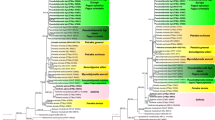Abstract
The teleomorph of Petrakia echinata (Peglion) Syd. & P. Syd. on leaves of Acer pseudoplatanus is described based on field collections, culture studies and ITS sequencing and was assigned to the genus Mycodidymella C.Z. Wei, Y. Harada & K. Katumoto. In addition, a Mycopappus anamorph and a presumed spermatial Phoma stage were observed and conspecificity with P. echinata was confirmed by culture morphology and ITS sequencing. The phylogenetic relationships between the Mycodidymella teleomorph of P. echinata and related taxa were studied using LSU nDNA sequences. The fungus causes brown spots on the leaves of the host plant, known as “Petrakia leaf blotch of sycamore maple”.




Similar content being viewed by others
References
Aas G, Zielinska D, Lauerer M (2010) Naturverjüngung von Acer saccharinum auf einer Ruderalfläche in Bayreuth. Ber Bayerischen Botanischen Ges 80:161–167
Ahlich K, Rigling D, Holdenrieder O, Sieber TN (1998) Dark septate hyphomycetes in Swiss conifer forest soils surveyed using Norway-spruce seedlings as bait. Soil Biol Biochem 30(8/9):1069–1075
Aptroot A (2006) Mycosphaerella and its anamorphs: 2. Conspectus of Mycosphaerella. CBS Biodivers Ser 5:1–231
Brandenburger W (1985) Parasitische Pilze an Gefässpflanzen in Europa. Gustav Fischer Verlag, Stuttgart
Butin H (2011) Krankheiten der Wald- und Parkbäume. Ulmer, Stuttgart
Corbaz R (1956) Recherches sur le genre Didymella Sacc. J Phytopathol 28:375–414
Crous PW (1998) Mycosphaerella spp. and their anamorphs associated with leaf spot diseases of Eucalyptus. Mycol Mem 21:1–170
Crous PW, Braun U, Wingfield MJ, Wood AR, Shin HD, Summerell BA, Alfenas AC, Cumagun CJR, Groenewald JZ (2009) Phylogeny and taxonomy of obscure genera of microfungi. Persoonia 22:139–161. doi:10.3767/003158509x461701
Funk A, Dorworth CE (1988) Mycosphaerella mycopappi sp. nov. and its anamorphs on leaves of Acer macrophyllum. Can J Bot 66(2):295–297
Greene HC (1960) Notes on Wisconsin parasitic fungi. XXVI. Transactions of the Wisconsin Academy of Sciences. Arts Lett 49:85–111
Grünig CR, Linde CC, Sieber TN, Rogers SO (2003) Development of single-copy RFLP markers for population genetic studies of Phialocephala fortinii and closely related taxa. Mycol Res 107(11):1332–1341
Grünig CR, McDonald BA, Sieber TN, Rogers SO, Holdenrieder O (2004) Evidence for subdivision of the root-endophyte Phialocephala fortinii into cryptic species and recombination within species. Fungal Genet Biol 41(7):676–687
Grünig CR, Brunner PC, Duò A, Sieber TN (2007) Suitability of methods for species recognition in the Phialocephala fortinii–Acephala applanata species complex using DNA analysis. Fungal Genet Biol 44:773–788
Kehr R, Butin H (2008) Vorkommen und Entwicklung der PetrakiaBlattbräune des Berg-Ahorns. Mitt Julius-Kühn-Institut 417:350–351
Kirisits T (2007) Die Petrakia-Blattbräune des Bergahorns. Forstschutz Aktuell (Wien) 40:28–31
Kollar A (1996) Evidence for loss of ontogenetic resistance of apple leaves against Venturia inaequalis. Eur J Plant Pathol 102:773–778
Leach CM (1971) A practical guide to the effects of visible and ultraviolet light on fungi. In: Booth C (ed) Methods in Microbiology, vol 4. Academic, London, pp 609–664
Meier F, Engesser R, Forster B, Odermatt O, Angst A (2008) Forstschutz-Überblick 2007. Eidgenössische Forschungsanstalt für Wald. Schnee und Landschaft WSL, Birmensdorf
Petrak F (1966) Über die Gattungen Petrakia und Echinosporium. Sydowia 20:186–189
Posada D, Crandall KA (1998) Modeltest: testing the model of DNA substitution. Bioinformatics 14(9):817–818
Samuels GJ (1980) Ascomycetes of New Zealand 1. Ohleria brasiliensis and its Monodictys anamorph, with notes on taxonomy and systematics of Ohleria and Monodictys. N Z J Bot 18:515–523
Schoch CL, Seifert KA, Huhndorf S, Robert V, Spouge JL, Levesque CA, Chen W (2012) Nuclear ribosomal internal transcribed spacer (ITS) region as a universal DNA barcode marker for Fungi. Proc Natl Acad Sci U S A 109(16):6241–6246. doi:10.1073/pnas.1117018109
Swofford DL (1998) Phylogenetic analysis using parsimony (and other methods). Sinauer Associates, Sunderland
Vilgalys R (1992) Conserved primer sequences for PCR amplification and sequencing from nuclear ribosomal RNA, vol 2011. vol December 1, 2011. Botany Department, Duke University, http://www.biology.duke.edu/fungi/mycolab/primers.htm, accessed: December 1, 2011, Durham NC, USA
von Arx JA, Müller E (1975) A re-evaluation of the bitunicate ascomycetes with keys to families and genera. Stud Mycol 9:1–159
Wei CZ, Harada Y, Katumoto K (1998) Mycodidymella aesculi gen. et sp. nov. and its synanamorphs Blastostroma aesculi gen. et sp. nov. and Mycopappus aesculi sp. nov. on Aesculus turbinata in Japan. Mycologia 90(2):334–345. doi:10.2307/3761311
White TJ, Bruns TD, Lee S, Taylor J (1990) Amplification and direct sequencing of fungal ribosomal RNA genes for phylogenetics. In: Innis MA, Gelfand DH, Sninsky JJ, White TJ (eds) PCR Protocols: A Guide to Methods and Applications. Academic Press, Inc., Harcourt Brace Jovanovich, Publishers, New York, pp 315–322
Zhang Y, Crous PW, Schoch CL, Hyde KD (2012) Pleosporales. Fungal Divers 53(1):1–221. doi:10.1007/s13225-011-0117-x
Acknowledgments
We thank the curator of the Museum Harmas Jean-Henri Fabre, Vaucluse, France, and Pierre-Arthur Moreau, Université Lille Nord de France, Lille, France, for their help with some herbarium specimens, Reinhard Berndt, the curator of the herbarium ZT, for taxonomic advice, Lioba Paul for specimen collections and improvements of the text, Angelo Duò, ETH Zurich, for DNA extraction and sequencing, and Julia Coffin, ETH Zurich, for linguistic revision of the manuscript.
Author information
Authors and Affiliations
Corresponding author
Rights and permissions
About this article
Cite this article
Butin, H., Holdenrieder, O. & Sieber, T.N. The complete life cycle of Petrakia echinata . Mycol Progress 12, 427–435 (2013). https://doi.org/10.1007/s11557-012-0850-x
Received:
Revised:
Accepted:
Published:
Issue Date:
DOI: https://doi.org/10.1007/s11557-012-0850-x




